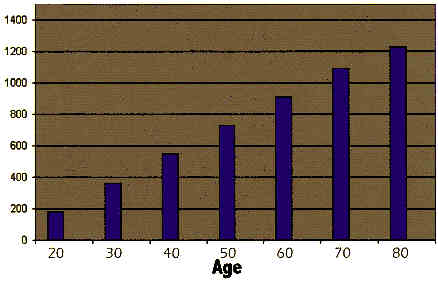 he
increased environmental presence of various toxic heavy metals
is the by-product of living in an industrialized society.
But preventative measures can be taken - chiefly, the use
of chelating agents. he
increased environmental presence of various toxic heavy metals
is the by-product of living in an industrialized society.
But preventative measures can be taken - chiefly, the use
of chelating agents.
 The most widely
publicized toxic metal is mercury (mostly from amalgam fillings).
According to
one prominent medical lab diagnoses can include numbness, fibromyalgi, allergies, chronicle tiredness, Crohn's disease, eczema, autoimmune diseases, multiple scleros, electricity sensitivity, rheumatic diseases, bruises, bad memory, prolonged fever, candida, diarrhea, and sensitivity to light and noise. Mercury and lead can both contribute to
low-grade mental illness, while lead and cadmium are
major contributors to
cancer. The most widely
publicized toxic metal is mercury (mostly from amalgam fillings).
According to
one prominent medical lab diagnoses can include numbness, fibromyalgi, allergies, chronicle tiredness, Crohn's disease, eczema, autoimmune diseases, multiple scleros, electricity sensitivity, rheumatic diseases, bruises, bad memory, prolonged fever, candida, diarrhea, and sensitivity to light and noise. Mercury and lead can both contribute to
low-grade mental illness, while lead and cadmium are
major contributors to
cancer.
 Some lesser known toxic metals
are just beginning to come to light - and they, too, can be removed
with chelation therapy. One recent report highlighted the
work-related dangers of
exposure to beryllium, and, in fact, there is at least one lawsuit
detailing the nature of high-level government cover-up in suppressing
information about its toxicity. (What makes the beryllium cases unusual
is that the nature of its toxicity
is so well known.)
Despite the existence of over 6,000 pages detailing the existence of
"Beryllium Disease,"
government and industry continue to work in unison to downplay its effects,
in order to minimize liability. Some lawmakers have called for
beryllium tests for military workers. Some lesser known toxic metals
are just beginning to come to light - and they, too, can be removed
with chelation therapy. One recent report highlighted the
work-related dangers of
exposure to beryllium, and, in fact, there is at least one lawsuit
detailing the nature of high-level government cover-up in suppressing
information about its toxicity. (What makes the beryllium cases unusual
is that the nature of its toxicity
is so well known.)
Despite the existence of over 6,000 pages detailing the existence of
"Beryllium Disease,"
government and industry continue to work in unison to downplay its effects,
in order to minimize liability. Some lawmakers have called for
beryllium tests for military workers.
Other Culprits
 Other less known or less prominent
metals, which can also be removed through chelation therapy, are worth
noting. Other less known or less prominent
metals, which can also be removed through chelation therapy, are worth
noting.
Cadmium

 Cadmium
is a
heavy metal
widely used in industry. Recent reports have
highlighted
medical waste incinerators as a major source of exposure
to the public. Other sources include
cigarettes,
soft drinks, water softeners, seafood, rubber, motor oil, pesticides,
fungicides and poly-vinyl plastics. Cadmium can cause chronic
fatigue syndrome, hair loss, high blood pressure, edema,
arthritis, kidney stones, and impotence.
Cadmium
is a
heavy metal
widely used in industry. Recent reports have
highlighted
medical waste incinerators as a major source of exposure
to the public. Other sources include
cigarettes,
soft drinks, water softeners, seafood, rubber, motor oil, pesticides,
fungicides and poly-vinyl plastics. Cadmium can cause chronic
fatigue syndrome, hair loss, high blood pressure, edema,
arthritis, kidney stones, and impotence.
Arsenic

 Arsenic is also
found in cigarette smoke, laundry detergents, beef, seafood
and drinking water. It can cause headaches, confusion and
sleepiness. It candamage the kidneys, liver, and the lungs.
Like beryllium, arsenic has been linked to considerable
efforts by government and industry to
cover-up its effects and downplay the exposure risks. Arsenic is also
found in cigarette smoke, laundry detergents, beef, seafood
and drinking water. It can cause headaches, confusion and
sleepiness. It candamage the kidneys, liver, and the lungs.
Like beryllium, arsenic has been linked to considerable
efforts by government and industry to
cover-up its effects and downplay the exposure risks.
Barium

 Barium compounds are found
in soaps, ceramics, paper, glass, plastics, textiles, dyes, fuel
additives, rubber, paint and pesticides. Barium toxicity can
cause vomiting, diarrhea, and abdominal pain. Barium compounds are found
in soaps, ceramics, paper, glass, plastics, textiles, dyes, fuel
additives, rubber, paint and pesticides. Barium toxicity can
cause vomiting, diarrhea, and abdominal pain.
Nickel

 Nickel is foundin stainless
steel cutlery, pots and pans, coins, dental fillings, and batteries.
It accumulates in the bones, kidneys, liver, lungs, immune system
and the brain, where it can cause genetic damage and cancer. Nickel is foundin stainless
steel cutlery, pots and pans, coins, dental fillings, and batteries.
It accumulates in the bones, kidneys, liver, lungs, immune system
and the brain, where it can cause genetic damage and cancer.
Dietary
Improvements
 Like so many health
hazards, changes in diet can deter or even eliminate
the threat of toxic health exposure, and in some cases
remove the threat after exposure has occurred. Like so many health
hazards, changes in diet can deter or even eliminate
the threat of toxic health exposure, and in some cases
remove the threat after exposure has occurred.
 Chief among these
limiting the intake of
seaweed, freshwater fish, pork, and crustaceans.
(We have problems with some of Dr. Huggins other recommendations,
and most people would compromise them anyway: cheese,
chocolate, white flour, sugar, etc. But the ones above
are confirmable and coincide with recommendations from
others both inside and outside the orthodox community.) Chief among these
limiting the intake of
seaweed, freshwater fish, pork, and crustaceans.
(We have problems with some of Dr. Huggins other recommendations,
and most people would compromise them anyway: cheese,
chocolate, white flour, sugar, etc. But the ones above
are confirmable and coincide with recommendations from
others both inside and outside the orthodox community.)
Other Options
 The primary purpose of this page
has been to educate as to the prevalence of toxic metal exposure.
It is not to infer that all toxic metals can be effectively
removed from the body using EDTA, whether taken intravenously,
orally, or rectally. Mercury poisoning, for one, has its own
unique challenges. EDTA is a
weak chelator of mercury, though it works for a wide variety
of other metals. (Dr. Cranton, one of EDTA's biggest proponent
recommends DMSA, administered orally, as the
"safest, most effective, and least expensive treatment for mercury removal".
The famous Dr. Huggins has interesting proposals on the
use of
butter to produce bile acid that binds and eliminates mercury.
(We feel they are worthy of examination, though it is worth noting
that others in the medical community do not support his findings.
From our perspective, butter, as saturated fat, as other dietary
negatives that should make any therapeutic use quite limited --
in quantity or duration. See flaxseed.) The primary purpose of this page
has been to educate as to the prevalence of toxic metal exposure.
It is not to infer that all toxic metals can be effectively
removed from the body using EDTA, whether taken intravenously,
orally, or rectally. Mercury poisoning, for one, has its own
unique challenges. EDTA is a
weak chelator of mercury, though it works for a wide variety
of other metals. (Dr. Cranton, one of EDTA's biggest proponent
recommends DMSA, administered orally, as the
"safest, most effective, and least expensive treatment for mercury removal".
The famous Dr. Huggins has interesting proposals on the
use of
butter to produce bile acid that binds and eliminates mercury.
(We feel they are worthy of examination, though it is worth noting
that others in the medical community do not support his findings.
From our perspective, butter, as saturated fat, as other dietary
negatives that should make any therapeutic use quite limited --
in quantity or duration. See flaxseed.)

|
Age Brings Increased Toxic Exposure
and increased exposure, in turn, accelerates aging ...
 Find your page at the bottom of each graph below.
The purple columns show the average amount of each toxic metal you have
ingested by that age. Toxic metals have been shown to cause hundreds of
diseases. To remove these toxic metals, Magnesium Di-Potassium EDTA,
as found in Medicardium may be indicated.
Find your page at the bottom of each graph below.
The purple columns show the average amount of each toxic metal you have
ingested by that age. Toxic metals have been shown to cause hundreds of
diseases. To remove these toxic metals, Magnesium Di-Potassium EDTA,
as found in Medicardium may be indicated.
Mercury (mg)


 Mercury is a
heavy metal
and potent neurotoxin. A primary source of exposure comes from
your own dentist - producing mercury exposure both while making
and inserting fillings, and
even more so after
removing them. Each silver (amalgam) filling
releases up to 17 mcg. of mercury every day. This increases to
500 mcg. with the smoking of cigarettes, the drinking of
hot liquids, gum chewing, acidic saliva or the grinding
of teeth at night. Mercury accumulates in the brain, heart,
kidneys, and endodrine glands and can cause depression,
auto-immune diseases, memory loss, tremors, anemia,
and heart attacks. Mercury is a
heavy metal
and potent neurotoxin. A primary source of exposure comes from
your own dentist - producing mercury exposure both while making
and inserting fillings, and
even more so after
removing them. Each silver (amalgam) filling
releases up to 17 mcg. of mercury every day. This increases to
500 mcg. with the smoking of cigarettes, the drinking of
hot liquids, gum chewing, acidic saliva or the grinding
of teeth at night. Mercury accumulates in the brain, heart,
kidneys, and endodrine glands and can cause depression,
auto-immune diseases, memory loss, tremors, anemia,
and heart attacks.
Uranium (mcg)


 Uranium is a radioactive
element that disintegrates eventually into lead. There have been
2,000 nuclear detonations on our planet since Hiroshima, casting
uranium into our atmosphere, not counting events like
Three Mile Island and Chernobyl. More recently, environmental
uranium has seen an upsurge with the
expanded
use of deleted uranium militarily. Radioactive materials can cause
cancer and birth defects. Uranium is a radioactive
element that disintegrates eventually into lead. There have been
2,000 nuclear detonations on our planet since Hiroshima, casting
uranium into our atmosphere, not counting events like
Three Mile Island and Chernobyl. More recently, environmental
uranium has seen an upsurge with the
expanded
use of deleted uranium militarily. Radioactive materials can cause
cancer and birth defects.
Lead (grams)


 Lead is a
heavy metal
found in
cigarettes,
cosmetics,
plastics, batteries, gasoline, insecticides, pottery glaze, soldered
pipes, and paint. Although one of the most common sources of exposure
has been determined to be
ordinary drinking water,
little action has been taken to mitigate public exposure.
The U.S. General Accounting Office recently admitted that about
50% of the U.S. population
alone may be getting unsafe levels of lead exposure from this source.
Other reports concur
and have concluded that decaying plumbing is another major source
of exposure (mostly from solder in modern plumbing; from the plumbing
itself in lines installed before 1930).
Lead accumulates in the brain, spleen, liver,
kidneys, and bones. Like mercury, lead is well-established as
a powerful
neurotoxin
and a leading cause of
pediatric neurotoxicity.
It has been strongly linked to
child delinquency
For each 30 mcg. of lead in a child's blood,
his or her IQ drops 10 points.
Lead is a
heavy metal
found in
cigarettes,
cosmetics,
plastics, batteries, gasoline, insecticides, pottery glaze, soldered
pipes, and paint. Although one of the most common sources of exposure
has been determined to be
ordinary drinking water,
little action has been taken to mitigate public exposure.
The U.S. General Accounting Office recently admitted that about
50% of the U.S. population
alone may be getting unsafe levels of lead exposure from this source.
Other reports concur
and have concluded that decaying plumbing is another major source
of exposure (mostly from solder in modern plumbing; from the plumbing
itself in lines installed before 1930).
Lead accumulates in the brain, spleen, liver,
kidneys, and bones. Like mercury, lead is well-established as
a powerful
neurotoxin
and a leading cause of
pediatric neurotoxicity.
It has been strongly linked to
child delinquency
For each 30 mcg. of lead in a child's blood,
his or her IQ drops 10 points.
Aluminum (grams)


 Aluminum can be found in drinking
water, antiperspirants, baking powders, feminine hygiene products, cow
and soy milk, baby formula, antacids, and of course aluminum foil,
pots and pans. It accumulates in the skin, bones, brain and
kidneys and can cause Alzheimer's and Parkinson's disease. Aluminum can be found in drinking
water, antiperspirants, baking powders, feminine hygiene products, cow
and soy milk, baby formula, antacids, and of course aluminum foil,
pots and pans. It accumulates in the skin, bones, brain and
kidneys and can cause Alzheimer's and Parkinson's disease.
|
 Aging & Chelation
Aging & Chelation Health care in the West, as we say
repeatedly throughout this Site, is based on dysfunction. Action
is largely keyed to disease - there is much less attention on
measures that would prevent the disease in the first place.
Health care in the West, as we say
repeatedly throughout this Site, is based on dysfunction. Action
is largely keyed to disease - there is much less attention on
measures that would prevent the disease in the first place.















